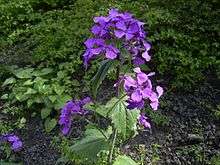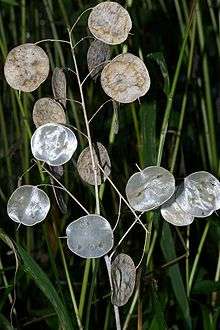Lunaria annua
Lunaria annua, called honesty or annual honesty in English, is a species of flowering plant native to the Balkans and south west Asia, and naturalized throughout the temperate world.
| Annual honesty | |
|---|---|
 | |
| Scientific classification | |
| Kingdom: | Plantae |
| Clade: | Tracheophytes |
| Clade: | Angiosperms |
| Clade: | Eudicots |
| Clade: | Rosids |
| Order: | Brassicales |
| Family: | Brassicaceae |
| Genus: | Lunaria |
| Species: | L. annua |
| Binomial name | |
| Lunaria annua | |

Description
It is an annual or biennial growing to 90 cm (35 in) tall by 30 cm (12 in) broad, with large, coarse, pointed oval leaves with marked serrations. The leaves are hairy, the lower ones long-stalked, the upper ones stalkless.[1] In spring and summer it bears terminal racemes of white or violet flowers, followed by showy, green through light brown, translucent, disc-shaped[1] silicles (not true botanical seedpods). When a silicle is ripe and dry, a valve on each of its sides readily falls off, and its seeds fall off a central membrane which has a silvery sheen, 3–8 cm (1–3 in) in diameter; the membrane can persist on a plant throughout a winter depending on the weather.[2] These silicles are much used in dry floral arrangements.
Etymology
The Latin name lunaria means "moon-shaped" and refers to the shape and appearance of this species' silicles.[3] The common name "honesty" arose in the 16th century, and may also relate to the translucence of its silicle membranes. In South East Asia, it is called the "money plant" and in the United States it is commonly known as "silver dollars", "Chinese money", or "Chinese coins" because its silicle membranes have the appearance of silvery coins. For the same reason, in French it is known as monnaie du pape ("Pope's money"). In Denmark it is known as judaspenge and in Dutch-speaking countries as judaspenning (both meaning "coins of Judas"), an allusion to the story of Judas Iscariot and the thirty pieces of silver he was paid for betraying Christ.[4]
Cultivation
This plant is easy to grow from seed and tends to naturalize. It is usually grown as a biennial, being sown one year to flower the next. It is suitable for cultivation in a shady or dappled area, or in a wildflower garden, and the flowers and dried silicles are often seen in flower arrangements.[3] Numerous varieties and cultivars are available, of which the white-flowered L. annua var. albiflora[5] and the variegated white L. alba var. albiflora 'Alba Variegata'[6] have won the Royal Horticultural Society's Award of Garden Merit.[7]
See also
- Dame's violet, Hesperis matronalis, a similar and related plant, but with long cylindrical seedpods instead of flat papery disks.[8]
- Lunaria rediviva (perennial honesty)
- Pilea peperomioides, another plant known colloquially as the Chinese money plant.
Gallery
- Unripe seedpod in July
 Detail of flower
Detail of flower- White-flowered form
 Storage roots at the end of first growth period
Storage roots at the end of first growth period
References
- Parnell, J. and Curtis, T. 2012 Webb's An Irish Flora. Cork University Press ISBN 978-185918-4783
- RHS A-Z encyclopedia of garden plants. United Kingdom: Dorling Kindersley. 2008. p. 1136. ISBN 1405332964.
- Coombes, Allen J. (2012). The A to Z of plant names. USA: Timber Press. pp. 312. ISBN 9781604691962.
- "Judaspenning", Van Dale's Groot woordenboek van de Nederlandse taal, online edition, retrieved 23 May 2020
- "RHS Plant Selector - Lunaria annua var. albiflora". Retrieved 22 May 2013.
- "RHS Plantfinder - Lunaria alba var. albiflora 'Alba Variegata'". Retrieved 25 March 2018.
- "AGM Plants - Ornamental" (PDF). Royal Horticultural Society. July 2017. p. 62. Retrieved 25 March 2018.
- "Money Plant (Lunaria annua)". www.illinoiswildflowers.info.
External links
- Jepson Manual Treatment
- USDA Plants Profile
- Photo gallery

